On May 21, 1944, the armed forces of the United States were preparing to invade Saipan and Guam. The Saipan invasion was the
Pacific front's version of D-day. Called "Operation Forager," it was to take place on June 14, 1944,
eight days after the Normandy invasion.
My shipmates and I aboard LST-126, already seasoned veterans, knew that something
big was brewing even though some still didn’t shave yet. West Loch, Hawaii, where we were moored, was the staging area for the invasion fleets of the Pacific. For weeks we had watched the
29 or so LSTs attached to Northern Attack Force, Task Force 52 being loaded with combat stores and ammunition at West Loch’s Lualualei Naval
Ammunition Depot.
At 327 feet, an LST was approximately as long as football field. Drawing only 14 feet fully loaded aft and 8 feet at the
bow, it rode high in the water, not exactly a ship one prone to sea sickness wanted to be on, but their short drafts had one distinct advantage,
torpedoes aimed at LSTs often passed harmlessly underneath.
The LST's flat bows and bottoms allowed closer access to the beach for ease in loading and unloading. Things such as
troops, tanks, munitions and even railroad cars were transported on LSTs because they could be unloaded without the benefit of a pier or dock. With
a maximum speed of 11 knots, they referred to by their crews as ‘Long Slow Targets.’
My ship, LST-126, was laid down on June 11, 1943 at Evansville, Indiana, by the Missouri Valley Bridge & Iron Co. She was
launched on August 28, 1943 and commissioned on October 2, 1943, Lt. M. A. Cassell in command. Less then three months later, we saw our first
action in the Marshall Islands, were we precipitated in the invasions of Kwajalein and Majuro Atolls.
Sunday morning, May 21, 1944, 29 LSTs were nestled together at six berths, readied for the invasion of Saipan. While at the
time we did not know our destination, we did know we would be leaving in a day or too. We were berthed at T-5 with LST-242 inboard and
LST-121 outboard plus two other LSTs. Like most ships that day, two thirds of our crew on liberty.
The morning passed peacefully, and while as Boatswain mate 2nd class I had lots of work to do, I still nevertheless found
time to enjoy the warm winds of the topical paradise I was in - I was a long way from my home in Camp May, New Jersey and I knew it.
 After lunch I was assigned to Assistant 1st LT, Ensign Claussen in inspecting the lashings that held LCT-926 to our main deck. The week before, during practice landing maneuvers off Maui, several LSTs
lost their LCTs overboard as a result of heavy rolls the LST’s took in bad weather. Thankfully we were not one of those and the captain wanted to
make sure we never would be.
After lunch I was assigned to Assistant 1st LT, Ensign Claussen in inspecting the lashings that held LCT-926 to our main deck. The week before, during practice landing maneuvers off Maui, several LSTs
lost their LCTs overboard as a result of heavy rolls the LST’s took in bad weather. Thankfully we were not one of those and the captain wanted to
make sure we never would be.
After verifying its securing lashing, Ensign Claussen and I moved on to inspect the 50 drums of aviation gas stored above
deck on the port bow. The gas was used in the ship’s 18 LVTs (Landing Vehicle Track a.k.a. Alligator) air cooled aircraft engines. The gas was
stored above deck because there was no place to store it below decks. Everyone knew it was a safety hazard, but we had no other choice, as bringing a
tanker into an combat zone was out of the question. Instead, LSTs served as a the fleets "just-n-time" supply source."
Like every other LST, we were fully loaded with ammunition for ourselves and other ships such as 750 rounds of 5" 38 ammo
for destroyers. The projectile were stored in the open under the LCT-in 375 wooden boxes, two shells to a box. All the powder was stored in the
forward 40mm magazine locker or the 3" 50mm aft magazine.
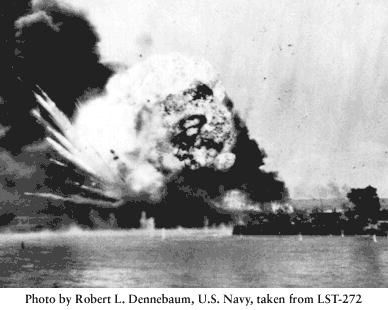 After concluding the inspection I headed to the
mess hall for a can of soda, I was sipping it when I heard a loud noise sounding like an explosion. It was exactly 3:08 pm. Everybody cleared out from
below decks and headed to the main deck to see what had happened. I could see a large cloud of smoke coming from a group of LSTs moored about 300
yards away in a nest of 8 LST-berthed at ___ #8. I would later learn the smoke was coming from LST-353.
After concluding the inspection I headed to the
mess hall for a can of soda, I was sipping it when I heard a loud noise sounding like an explosion. It was exactly 3:08 pm. Everybody cleared out from
below decks and headed to the main deck to see what had happened. I could see a large cloud of smoke coming from a group of LSTs moored about 300
yards away in a nest of 8 LST-berthed at ___ #8. I would later learn the smoke was coming from LST-353.
I climbed up to the boat deck to get a better look, and I had no sooner reached the deck when explosions began to rip the
invasion fleet apart. All hell was breaking loose. Explosions were sending fiery debris high into the air, and onto the decks of nearby moored ships
causing a chain reaction of fire and fury. After the third explosion, everyone knew this was not place to be, especially with all the exposed gas
and explosives on our deck. Unless we got underway, it was only a matter of time before we became part of the conflagration.
With explosions echoing off the surrounding hills, general quarters was sounded. Ensign Claussin came running down the deck
hollering for me and Seaman Steven ‘Sack’ Sacoolidge to man the LCVP (Landing Craft Vehicle Personnel) that was tied off our stern. We didn’t need
to be told twice. Scampering down the Jacob’s Ladder, I rushed to the engine controls and started the engine while Sack hurriedly untied the lines.
Once in mid-channel, we could clearly see the disaster that was taking place about 300 yards away. Red-hot fragments
showered the clustered LSTs (LST 39, 353, 179, 43, 69, 274, 225, 205), igniting gasoline drums lined up on their exposed forecastles. Ships
everywhere were burning. The sky was quickly filling with thick black smoke. I could see men huddled on the sterns, as well as in the water
alongside the ships.
Without giving it a second thought, I told Sack that we were going in and gunned the engine and headed for outboard and
nearest LST: LST-39. As we headed in fiery debris rained all about us. Sack hurriedly tossed overboard the garbage cans that crowded our VP’s deck,
he no sooner threw the last can over then we began to pull in men that were in the water. Once everyone in the water was aboard, we moved alongside
LST-39's starboard quarter.
In spite of the height, sailors and marines jump directly into our boat. I’m sure many suffered broken arms or legs, but at
the time, no one seemed to care. They were safe and that’s all that mattered. Ocne safely aboard, they turned their attention to helping Sack help
their shipmates aboard. Once we had collected everyone we could at a particle LST, I maneuvered to another LST to picked up survivors. How long I
stayed next to the group of LST, I’ll never know.
With the boat full and no one else in sight, I gunned the engines and started to pull away to safety. As I did, I saw
somebody running aft on LST-39 and hollering something - I was about to turn around when LST-39 was rocked by another explosion. The man on deck
turned and ran away and I never saw him again.
I headed across West Loch to the ammo wharf. Where we were greeted by the ammo handling crews. Those not injured helped
those that were out of the boat. We all turned and looked at what we had escaped. Even from that distance, I could see more men jumping off the LSTs
we had just left. Realizing that certain death awaited them in the flaming, oil-soaked waters, I asked several of the men we had pulled from the
water if they would stay and help us rescue them. No one refused. We never had time to exchange names, and I never met them again, but they
are heroes to
me just the same.
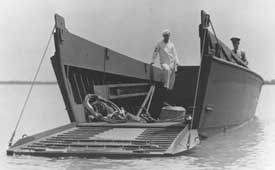 We headed for the middle of burning group of LST. About
100 yards from it we began pulling men from the water, however the oil slick that now covered the bay made it hard getting them into the boat. Out
of the corner of my eye I saw another LCVP that had lowered its bow ramp to the level of the water, allowing its crew to stand on the ramp and to
literally ‘scoop’ men out of the water. It looked like a good idea so I followed suit.
We headed for the middle of burning group of LST. About
100 yards from it we began pulling men from the water, however the oil slick that now covered the bay made it hard getting them into the boat. Out
of the corner of my eye I saw another LCVP that had lowered its bow ramp to the level of the water, allowing its crew to stand on the ramp and to
literally ‘scoop’ men out of the water. It looked like a good idea so I followed suit.
Putting the ramp down in the middle of the harbor, even in the best of situations was not without its risks. All that was
needed to sink us was a small wave. We had managed to only get in a few men when an LST, attempting to escape the area, passed us going flank
speed, which created a large wake which rolled into the boat. As the boat filled with water, the sight of my LVCT sinking to the bottom of the bay
flashed before my eyes. Sack & I jumped to the cable winch that raised the ramp and cranked for all our worth. By the time we got the ramp closed,
we had about a foot of water over the floor boards.
To add injury to insult, the propeller was becoming fouled with
debris. I was still able to maneuver but at a slower speed.
For the next 25 minutes we continued to pull men from the water, but with the oil all around us now catching on fire, it was time to head for
safety.
As we left the area to leave, I saw one poor fellow hanging off the stern anchor on an LST-100 feet away. Everyone in the
boat yelled for him to jump and swim, but before you could blink your eye, the oil around the ship caught fire he disappeared into the flames. There
was nothing more we could do. I turned away from the burning ships and once again headed toward to the ammo wharf.
Sack and I never counted how many men we pulled from the water that afternoon. We never had time to. But if I had to guess,
it was between 30 to 40.
Once everyone was safely ashore, Sack and I tied up to the ammo wharf trying to figure out what to do next. Our boat
was covered with debris. Water from the flooded deck was leaking into the engine compartment which was now close to half full, and the propeller was
fouled.
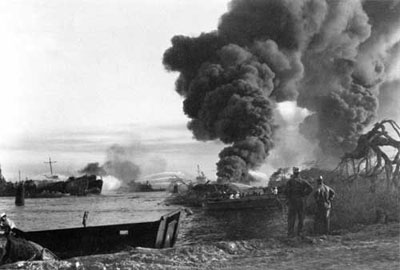 As our LST had headed out to sea moments after we
had untied, we had no place to go. And with all the explosions going on about us, we knew two guys in a garbage scow were not top priority.
As our LST had headed out to sea moments after we
had untied, we had no place to go. And with all the explosions going on about us, we knew two guys in a garbage scow were not top priority.
With the burning LSTs were now drifting towards us and the Ammo dock, I made my mind to head across the channel the morning
berth where my LST had been tied too. Once secured we turned our attention to the water in the boat. Using a hand bilge pump and a battle helmet we
tried to dewater her, but after half and hour and not much showing for all our work, we quit.
Now all but disabled, we could do nothing
but stand and watch the destruction happening before us. We had
50-yard line seats 200 yards from the action - but it was a show we
would rather not have seen.
LST-39 was now adrift and in the middle of the channel, lees then 200 yards from us. A tug boat was alongside her pumping
hundreds of gallons of water a minute onto her in a desperate attempt to put out the fire raging on her deck. It was like spitting into a fire. As
flames lapped at the deckhouse, the control center of the ship, her 3" magazine exploded. The explosion lifted the deckhouse skywards and onto the
tug boat. Remarkably, the tug boat survived. It was now approximately six o’clock. The bright sunshine that greeted me in the morning seemed an
eternity ago.
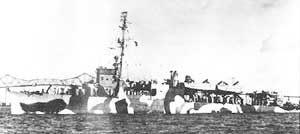 Seeing LST-39 exploded before our eyes re-energized Sack
and I. Casting about for some way to get the boat out of the water, we caught sight of four old four-stack destroyers (APDs) and a LST, still tied
together and unscathed by the events of the day. Unable to get steam up to get underway, they were forced to stay put.
Seeing LST-39 exploded before our eyes re-energized Sack
and I. Casting about for some way to get the boat out of the water, we caught sight of four old four-stack destroyers (APDs) and a LST, still tied
together and unscathed by the events of the day. Unable to get steam up to get underway, they were forced to stay put.
I was unable to approach her because the LST
was tied inboard, so I continued on. As I did, I saw another LST about 200
feet further in in Walker Bay. LST-274 had been part of the original group that had caught fire in the morning. She had managed to break free and
ran herself into Walker Bay and beached herself. Unlike here sister LSTs, she had managed to put out her fires.
Nursing the boat forward, I pulled alongside her and asked if they could lend us a hand. The crew lost no time in lending us
a hand. Once clear of the water the bilge plugs were pulled and the water that covered our deck began to drain. Once over the LST’s deck, I jumped
off to inspect the propeller, which as I suspected, was ensnared with rope, sewage, and other trash.
As the water drained, we inspected the damage. On the floor boards inside the coxswain station between where my feet would
be when maneuvering the boat, I found was a piece of steel about the size of a baker's rolling pin imbedded into the wood. It took a crow bar to pry
it loose. It must have hit while I was busy helping pull sailors on board. Had I been in the coxswain’s station when it had hit, I would not be
writing this today.
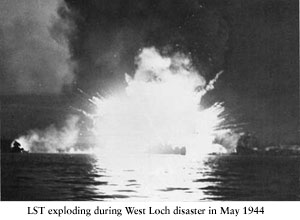 While cleaning the boat, the Captain of the
274 came by and told us he wanted us to stay as he had no boats of his own at the time. It was
not exactly an order to stay, rather, it was more of a
request, but as we had no other place to go, it seemed a good idea to us at the time. The crew treated us as one of their own. Sack and I did
not
sleep much that night, mostly we watched ships burn and explode and we thanked God we were still alive.
While cleaning the boat, the Captain of the
274 came by and told us he wanted us to stay as he had no boats of his own at the time. It was
not exactly an order to stay, rather, it was more of a
request, but as we had no other place to go, it seemed a good idea to us at the time. The crew treated us as one of their own. Sack and I did
not
sleep much that night, mostly we watched ships burn and explode and we thanked God we were still alive.
The following afternoon, the 126 came back into port. Thanking the crew of the 274, we headed back to our own ship. Upon
reporting aboard we were called to the wardroom where our CO: Lt. Kruger, sat us down and poured us some coffee. The last time he saw us, he was
headed out to sea as we were headed toward an exploding LST. He wanted to hear about it first hand what we had done.
While fires smoldered for several more days, life soon returned to normal, normal of course being all relative. Military
authorities warned survivors not to discuss the incident to protect the scheduled invasion of the Marianas.
Four days after the disaster, authorities released a one paragraph statement acknowledging only that an explosion had caused
"some loss of life, a number of injuries and resulted in the destruction of several small vessels." Despite the tragedy, the invasion fleet was able
to set sail, delayed by only one day.
The ever present dangers of the war soon made the events of May 21st a distant memory.
But while we might have forgotten, the Navy had not. A few weeks after the
invasion of Leyte, while the ship was in Holandia, New Guinea, a large envelope addressed to
Lt. Cassell, now the ship’s CO, arrived. In it were temporary citations for me and Sack. My citation read:
In the name of the President of the United States, the Commander in Chief, United States Pacific Fleet, takes great Pleasure
in presenting the NAVY and MARINE CORPS MEDAL to
BERNARD MAURICE HILLMAN
BOATSMAN'S MATE SECOND CLASS
UNITED STATES NAVY
"For heroism in rescuing injured enlisted men from being drowned or burned to death. Under conditions of great
personal danger from exploding vessels, and with complete disregard of his own safety, he voluntarily and courageously while serving as coxswain of
a small boat, maneuvered his craft alongside a ship in flames to rescue men from the ship and from the water, thereafter transporting them to a
place of safety. His heroic conduct, performed in the face of great danger to himself, was outstanding and in keeping with the highest
traditions of the naval service"
C. W. Nimitz
Admiral, U.S. Navy
On November 15, 1944, an award ceremony was held on the main deck where we presented the Navy and Marine Corps medal for
Heroism for our actions at West Loch. It would be another two years before I received a official citation signed by the Secretary of the Navy, for
the President of the United States himself.
Much as everyone would have like to celebrate, the war was never far from our minds. Less then six weeks later weeks later, LST
126 was once again in the thick of it during the invasion of Luzon. Little did I know at the time, it would be the last time I would see
action on her. In February, 1945, I received temporary orders to report to the Philadelphia Naval Bases, where I was to awaited while
permanent orders to a armored cargo ship where cut. In the meantime I enjoyed a month of liberty on the balmy Jersey coast of my youth, where
the war, the explosions a West Loch, the friends I had made, and those I had lost, seemed like a world unto itself.
Soon after my departure, LST 126 was ordered home also, where she underwent conversion into a ammo carrier, as the navy
prepared for what would be the biggest battle yet: the invasion of Japan. LST
126 had no sooner finished her conversion when the war ended. She
was decommissioned on June 17, 1946 and struck from the Navy list on June
23, 1947. On June 14, 1948, she was sold to the Oil Transport Co., of New Orleans,
Louisiana, for conversion to merchant service. What happened to that
old gal, I don't know. But she earned three
battle stars for her service in World War II.
Today, only a few reminders of the West Loch disaster remain. For years, both during the war and after, the disaster at West
Loch was veiled in secrecy and mystery. Several investigations sought to find the reason for such a disaster, but no conclusive evidence as to how it
occurred. Two major reasons have emerged as to the possible cause: the initial explosion was caused by gasoline vapor, or one
or more mortar shells exploded while being handled.
No attempt had been made to salvage most of the damaged LSTs. When the war was over, the Navy Bureau of Ordnance seeking to
test a new torpedo magnetic exploder, chose to use one of the damaged LST-as the target for the first live test. Towed to sea with a couple of big
pumps pumping like mad to keep her afloat, the LST stood silently, waiting for her end.
But as to show providence was on her side, the torpedo malfunctioned and never approached the waiting LST. When the pumps
that kept her afloat ran out of fuel, the LST, which had suffered so much on that fateful day in May 1944, slid peacefully below the waves.
Epilog
I was lucky to spend VE and VJ day at home. But as all my shipmates were being discharged with points, I being regular
Navy, still had three years more service to complete on my six year hitch. Many, in later life, wish they had been in my shoes and made the
Armed Service a career. Twenty-seven years later I retired as a Commander, USN retired, having risen from Seaman, to Chief Boatswain's Mate, to
Commissioned Officer.
Over the next 25 years, I was given the opportunity to attend many service schools, including ship salvage and deep sea
diving. I served on many ships, including LST 857, four Submarine Rescue Vessels,
two Submarine Tenders, not to mention numerous shore
assignment that allowed my wonderful wife and I to expose our family of seven to the wonders of this great country.
My twenty-seven years in the navy are full of many memories of great times, and great friends, more about them next time ...
Until then.